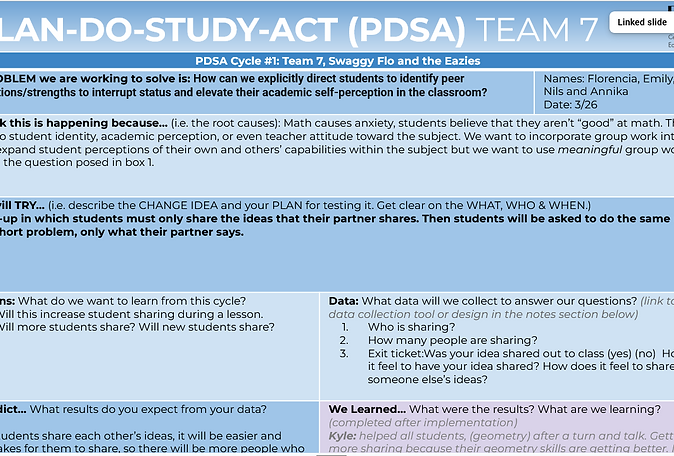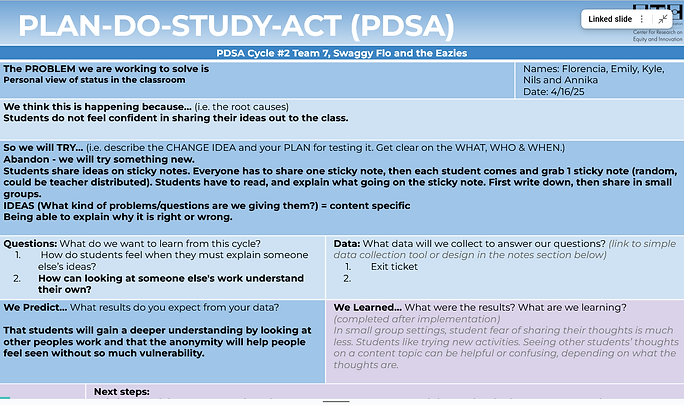MRKYLE.COM

Lesson Study Cycle 3
The Theme:
In this lesson study, we focused on the disruption of status within the classroom. We also took a look at how a student's own perception of their status can affect their ability to share their thoughts within the classroom.
The Content understanding goal:
Justice 14 JU.6-8.14 I know that all people (including myself ) have certain advantages and disadvantages in society based on who they are and where they were born.
Students will be able to apply equivalent ratios to real-life topics to analyze the inequality in San Diego’s city planning. they will show this by successfully completing the desmos task and showing their thinking behind their results.
Our Lesson plan
"Pre" lesson day
Our host teacher is working on a project around city planning with their students, and in order to give them access to the learning they will be teaching them important vocabulary and concepts so that they can engage meaningfully with our lesson.
Notes: we would later learn that students did have some background knowledge of the topic and our concerns were unwarranted. we assume that students often here older individuals discuss the cost of living in San Diego.
The Lesson Study
Students will start by working on a warm up which will frame their thinking for the Desmos lesson. The warm up brings into focus the social justice aspect of the lesson, and is meant to have students critically think about data.
Notes: the discussion on the ideas begind city planning for equity was very useful, and we noticed that timing is very important as we felt that more time was needed in order to do the topic justice. (the math aspect took a hit as the students were very engaged in the social aspect of the lesson).
Research
Key Takeaway:
Status can take many forms, and disrupting status can also be tackled in various ways. A personal take away I had was that my end goal isn't just getting everyone to raise their hand in class, it should be finding ways to allow each student to share their thinking in ways that they feel confident in. Lastly, not all forms of participation is created equal, there is a difference between a student answering simple question and a student explaining their own thought process.
A bonus idea that I took away was how connected all of the ideas in our lessons were, City planning can have an effect on status (where a student lives), it goes to show that there is so much that we need to monitor as thoughtful educators.
These ideas are what shaped our ultimate goal of disrupting status, as well as allowed us to see that there is not a one size fits all solution.
PDSA Data


Student work




Focus students
The goal of this lesson study was to essentially get students who may not normally feel confident to share their thinking, to feel emboldened to bring out their voices in the classroom. That being said we understood that this could look different for each student, which is why our focus was on getting students to share their thoughts in various ways during this lesson. For example students could share their thinking in Desmos, during turn and talks, and with the whole class. We also allowed students to fill out small forms that allowed students to share the thinking of their partners. We wanted the barrier for sharing to be as low as possible. During the lesson study we even had a student who shared the thinking of their partner, and this focus student was specifically chosen as they do not often share during class discussions.
Personal notes: I often took what I learned in this lesson study and applied the thinking to my own class. I saw similar situations in my own classroom, though since they are my students I have much greater understanding as to the why of certain things (for example one student not wanting to share out loud simply because they don't like speaking in front of other people.
Analysis and synthesis
Our Data Collection


During our discussions we discussed how not all forms of sharing thoughts in class are created equal, and that our data collection needed to account for this. For example someone answering simple questions or giving simple yes or no answers, yes this is sharing, but we believed that someone explaining their thinking behind answers and opinions should essentially "weigh more". We still want to monitor overall engagement, but we felt it was important to differentiate these types of engagement. We also included data on sharing within the Desmos lesson, as our lesson study focus was to have students share in a way that they are comfortable in, and Desmos allowed for a means to share that thinking anonymously.

Reflections and Takeaways
There was a lot to unpack for me with this lesson study. As we have learned about status in the classroom I have had some questions lingering for me. When I was in school I personally did not pick up on "status" so much of what I learn is surprising to me.
I often thought of status as either a "coolness" factor where a student who is perceived as cool has increased status, or a student being the "math" (or any subject) student and would have increased status during discussions of that topic. So in the discussion of disrupting status during a math lesson I thought that our goal was simply to get more students to raise their hand. After diving deeper into the topic I learned that there was more to this topic than I had initially thought (especially after some conversations with one of my professors). Disrupting status is about getting student thinking out into the space, and that it can take various forms. My professor brought up getting even the "math" student to see other student thinking and understanding that their thinking also has a place in the discussion.
As with most lesson study topics it isn't as simple as changing one things and fixing the problem. There are a plethora of reasons why a student may not want to share their thinking, and as educators we need to find ways for all students to have access to the discussion within our classrooms.